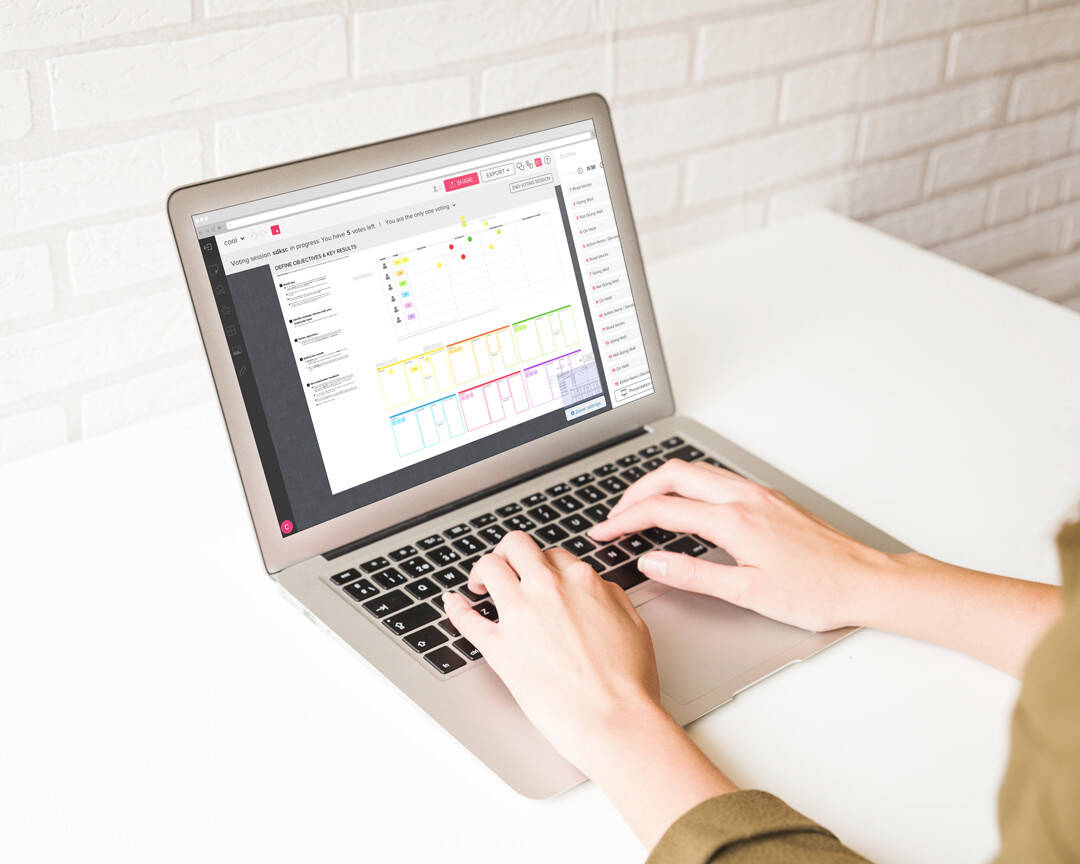Contxto – We can’t discuss startups without mentioning whiteboards and colorful sticky notes, can we?
As more companies start normalizing remote work and home offices as feasible working schemes, highly visual tasks like product design may sometimes fall by the wayside. Or at least, it used to.
Mural spotted that pain point.
Scroll down to understand more about Mural and how it could help your company’s design thinking and sprint journey.
Although I may not have taken advantage of all of its functionalities and features, I played around with it for quite some time. I’m still using the 30-day trial version to fully discover and explore the benefits and possibilities of Mural, so I will most likely update this post in the near future.
Brief
Description: Mural is a cloud-based interactive digital whiteboard allowing users to create, design, collaborate, share and keep track of visual workspaces. Its interface is both web and mobile friendly.
Country: Argentina
Industry: Enterprise Software – Saas
Founders: Agustin Soler, Mariano Suarez-Battan, Patricio Jutard
Founding Date: 2011
What?
Back in 2013, Mural called itself the “Google Docs for visual people,” but I truly think the group was underestimating itself. By far, it’s the easiest way for creative teams to think, imagine and discuss new ideas, or say it says. So far, I agree.
Mural is an online collaboration tool. It provides a virtual whiteboard or “play space” for users to create designs, charts, user flow diagrams or just basically anything that requires drawing or visual interpretation. Through its mobile and web-friendly interface, users can drag and drop sticky notes, images, links and even documents.
The digital platform is essentially a collaborative content map, blank canvas and clean whiteboard all wrapped up into one dynamic interface. Users come together to create and move fast on whatever project they’re trying to tackle.
How?
The founders used a design thinking approach to build the product and solve customers’ needs and desires.
Mural uses cloud-based interactive technology allowing patrons to collaboratively create and design technical diagrams and visual flows. All of this is done thanks to innovative web-based technology.
Funny thing: I was just about to publish this article when I received an email from Mural. Kind of creepy, to be honest.
Anyways, it helped me understand a couple more things, specifically about the startup’s security protocol and standards.
The company’s motto is: move fast, break nothing. For me, this reinforces its commitment to users’ data privacy – interesting timing based on what just happened (again) with Facebook, huh?
Mural applies various procedures to keep data safe while staying accessible:
- SOC 2 Type II Certified: product, infrastructure and policies have been audited and certified.
- Securely deployed infrastructure: with advanced protection and security controls on Microsoft Azure.
- High availability: no more than 20 percent of machines will be taken down at the same time for maintenance.
- Full redundancy for core services: multiple data centers.
- Risk management and threat mitigation: third-party periodic penetration and testing.
- Formal software development lifecycle methodology.
- Strict adherence to third-party standards: SOC II Type 2, Swiss-US Privacy Shield and EU-US Privacy Shield and GDPR.
- Customer data protection and backup: daily snapshots of entire databases plus 4-hour incremental backups, not to mention encryption. No employee has access to the client’s data without permission.
Why?
I am not a big fan of remote work and home office. However, the benefits of this working format cannot be disputed. According to a Stanford Study, remote working increased employee productivity by 13 percent.
According to an Owl Labs Survey, 24 percent of employees who work at least once a month from home report feeling more happy and productive in their current roles. Moreover, this is an evergrowing trend. Only 19 percent of companies allowed home office back in 2003, while 56 percent could do so in 2019.
Seeing how home offices are an undeniable part of the future with its various benefits, we need better virtual, non-physical collaboration systems. Mural achieves that by making teams’ lives easier with its flexible and affordable platform. Really, it does feel as if you’re doing everything by hand.
The usability of Mural goes way beyond designers and creatives. Whether you’re a developer, manager, project leader or even a teacher – Mural can definitely be useful. At the end of the day, it assists professionals seeking a secure, visual and interactive digital workspace to create as well as exchange ideas freely.
Story
Mural was founded in November 2011 by Agustin Soler, Johnny Halife, Mariano Suarez-Batta and Patricio Jutard. Although it is headquartered in San Francisco, all the founders are actually Argentine.
I recently came across one of their first blog posts. It’s quite interesting to understand what they were going through when they first launched a couple of years ago. Apparently, they signed around 5,000 people and presented their startup to the world during TechCrunch Disrupt back in 2012.
Evernote meets Prezi is what the famous tech blog called them, and I must say it is pretty accurate.
In that very same blog post, they narrate how Google’s Chrome team praised its overall UI. How so? It seems that they were “pushing the bar on what it could be done with HTML5.”
This is how it used to look a couple of years ago!

Status
Currently, the company is headquartered in San Francisco, although all of its development team is based in Buenos Aires. According to PR Newswire, the company landed a deal with IBM after completing IDEO’s Startup in Residence program, back in 2016.
Mural did not only participate but was purposefully chosen for the program. Over the course of several months, Mural refined its product right from IDEO’s San Francisco studio. During this time, the founders ran experiments and design challenges based on design thinking philosophy, as well as learning how to actually sell the platform through a B2B scheme.
According to PulsoSocial, Mural was already providing software services to clients such as IBM, Disney, Steelcase and even Stanford University in 2016.
“Mural has been fundamental in the deployment of our design thinking practices at IBM. Now we have thousands of people in over 50 countries collaborating through Mural”
From the looks of Mural’s interface plus the overall feel of the program, I’d say it has come a long way.
Business Model
Mural uses a B2B Saas business model. In terms of partners, there are two main types: teams and enterprises. The primary difference is the size of the team.
The first option permits two different pricing schemes, while the latter is mostly a customizable solution, thus offering flexible pricing packages. Mural charges monthly subscriptions to clients.
Take a look at this brief summary of their pricing options:
Mural for teams:
It’s a single workspace, designed specifically for small to medium-sized companies.
- For starters: Costing no more than US$12 per member/per month, this is the most basic option available. It grants all the basic content creator features, provides email and self-service support, grants access to educative webinars and can be integrated over Slack and Teams.
- Plus: It’s slighly pricier. At US$20 per member/per month, it has the same basic features plus some extra conveniences. It prioritizes support and provides quicker response time, guarantees 99.99 percent of uptime, offers oAuth2 single sign-on option and allows companies to pay with alternative methods.
Mural for enterprises:
There are multiple workspaces, especially useful for multifunctional and large-scale teams. Some of these perks include extreme support, personalized educative programs, ROI and progress tracking, as well as standardization of tools for internal content deployment.
Due to its flexibility and the different needs of corporate customers, the pricing option is mostly tailored to the clients’ preferences.
Funding
According to Crunchbase, the company has raised a total of US$2.3 million in three different seed rounds.
The startup’s most recent funding came from Alta Ventures, Intel Capital, NXTP Labs and Collaborative Fund for a total amount of US$1.35 million in 2016, joining past investors such as 500startups.
Future
Coming soon, my friends.
Thoughts
Designer-based thinking is a highly embraced philosophy across the tech industry. CEOs and leaders from Silicon Valley to Buenos Aires believe in the proper implementation of this mind frame to improve processes, user experiences and product development.
Mural’s UX is pretty seamless if you ask me. It’s as easy to implement as actually writing notes and pasting them on a whiteboard. What’s even better is that you can do this at scale. The array of actions available on the platform seem to be endless.
I’ll definitely continue to experiment some more.
-VC






